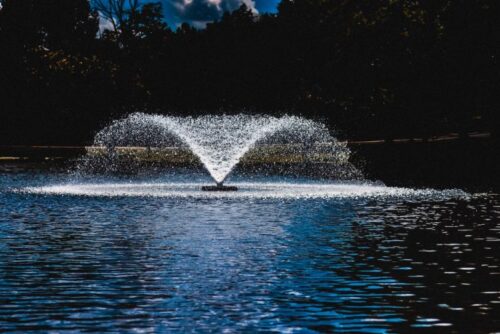When it comes to enhancing the aesthetics of living space, both indoor and outdoor fountains serve as a popular choice for homeowners, architects, and interior designers alike. These water features not only add a visual element of beauty but also create a soothing ambiance with their serene soundscapes. However, it’s essential to understand that indoor and outdoor fountains aren’t necessarily interchangeable. Each has its unique characteristics, use cases, and maintenance needs.

This guide aims to delve into the differences between indoor and outdoor fountains, offering insights into their interchangeability.
Design and Aesthetics
When looking for a fountain, the design and aesthetics are often two of the most important factors to consider. Outdoor fountains typically have larger designs with more detailed structures due to their location in an open space. They are also usually designed with materials that are resistant to harsh weather conditions like stone and metal. On the other hand, indoor fountains tend to be smaller and more compact, with delicate designs that fit into more confined spaces.
They are usually made from materials such as porcelain or ceramic for their lighter weight. You can find a wide variety of styles for both indoor and outdoor fountains, with options ranging from classic and traditional to modern and contemporary.
Installation Requirements
The installation requirements are different between the two types of fountains. Outdoor fountains require a more extensive set-up than their indoor counterparts due to having to be connected to an external water supply. Additionally, these water features generally need to be electrically wired and may require dedicated plumbing for a continuous flow of water. Indoor fountains, on the other hand, typically don’t need to be connected to an external water source and most are self-contained. This means they typically come with their own reservoir or basin that simply needs to be filled up and plugged into an electrical outlet.
Even more so, outdoor fountains need to be placed in areas with good drainage and access to sunlight. Indoor ones can be placed anywhere inside a home or business without needing any special considerations. Picking a place to place an indoor fountain is therefore much easier than an outdoor one.
Stress Relief
Indoor fountains are an amazing way to create a sense of peace and tranquility in the home. The sound of trickling water creates a calming atmosphere that can help soothe stress and anxiety. Among other benefits of indoor water fountains, studies have shown that the sound of gentle running water can help reduce stress hormones and lower blood pressure levels. Outdoor fountains also provide a sense of peace, but their larger scale often makes them better suited as focal points in outdoor spaces rather than for relaxation. A lot of people also find the sound of outdoor fountains to be too loud for relaxation purposes.
Water Source

Outdoor fountains, with their water source connected to an external system, demand extensive installation and ongoing maintenance. But oh, the rewards! The sound of flowing water, and the mesmerizing sights make it all worth it. Indoor fountains, on the other hand, are a breeze to maintain.
With their self-contained reservoirs, all they need is a little filling up by hand, and voila!
Some indoor fountains are compatible with water-recirculating systems, such as those used for outdoor fountains. This means that you could potentially install an outdoor fountain in your home if the space permits and it would still require minimal maintenance. However, due to their size and design, they usually make better choices for outdoor spaces.
Safety and Accessibility
When it comes to safety and accessibility, both indoor and outdoor fountains have their own unique considerations. Outdoor ones are usually designed with materials that can handle being outdoors in all kinds of weather conditions, but they can still be a safety hazard for kids or pets due to their open access.
Indoor fountains need to be placed away from electrical outlets and cords to avoid any potential hazards. Additionally, if you have pets or small children, it’s important to keep an eye on them around indoor fountains as they can be a drowning hazard. Having an indoor fountain with a locking cover or one that is elevated may be the best solution in this case.
Maintenance Needs
Proper maintenance is crucial for both indoor and outdoor fountains. Regular cleaning and monitoring of water levels are essential tasks. However, the frequency of maintenance depends on the climate in which the fountains are located. Outdoor fountains, with their exposure to dirt, debris, and the whims of Mother Nature, demand regular cleaning. Remember, they may also need extra protection against the fury of snow and hail.
On the other hand, indoor fountains bask in the luxury of less maintenance, as they are shielded from the environmental elements that challenge their outdoor counterparts. The usual cleaning routine that involves scrubbing and cleaning the surface of the fountain, as well as changing out the water, should do.
Interchangeability

While there is nothing stopping someone from placing an outdoor fountain indoors or vice versa, it is important to consider the difference between these two types of water features. An outdoor fountain may not be suitable for an indoor space due to its larger design and need for an external set-up. Likewise, an indoor fountain may not be designed to withstand the harsh elements of an outdoor environment. When making a decision between an indoor and outdoor fountain, it is important to consider the differences in design, installation requirements, stress relief capabilities, and maintenance needs of each type. Deciding if you would like your indoor space to include a fountain or an outdoor space to feature one is a personal choice, but it’s important to do some research first before purchasing. When you know what goes into the maintenance and installation process, you can be sure to make an informed decision that is right for your unique needs.
In conclusion, both indoor and outdoor fountains bring their own unique charm to a space. They differ in their design, installation requirements, purpose, maintenance needs, and safety considerations. Indoor fountains, with their self-contained nature, are easier to install and maintain, and they contribute a calming effect to the indoor environment. Outdoor fountains, on the other hand, require a more complex installation process and demand regular maintenance, but they offer a visually captivating and relaxing addition to your outdoor space. While you could potentially interchange these two types of fountains, it’s important to bear in mind their unique characteristics and requirements. Before making a purchase, assess your specific needs and the conditions of your space to ensure you select a fountain that suits you best.





